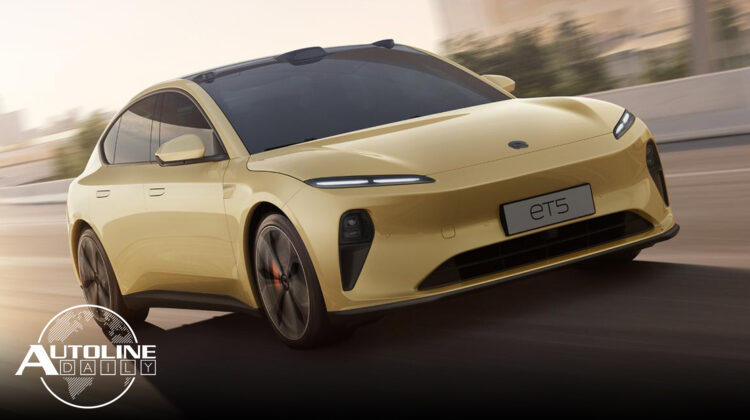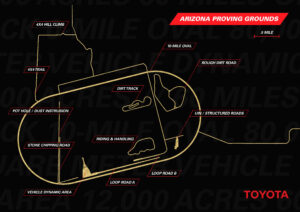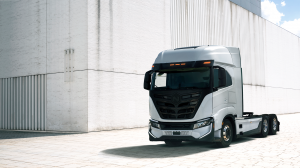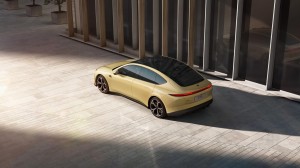
Listen to “AD #3227 – NIO Introduces New ET5 Sedan; EV Subsidies Dead in The Water; Nikola Delivers First Battery Electric Trucks” on Spreaker.
Follow us on social media:
Runtime: 8:50
0:08 EV Subsidies Dead in The Water
0:57 Why Dan Ammann Was Fired from Cruise
1:44 Toyota Opens Up Proving Ground to Any Automaker
3:00 Nikola Delivers First Battery Electric Trucks
3:52 Audi Opens First Charging Hub in Germany
4:29 Ford Offers CA EV Owners Zero-Carbon Charging
5:28 NIO Introduces New ET5 Electric Sedan
6:63 ZF Shows Off Steer-By-Wire System
7:42 Low Rolling Resistance Tires Have Longer Braking Distances
Visit our sponsors to thank them for their support of Autoline Daily: Bridgestone, Intrepid Control Systems and Schaeffler.
This is Autoline Daily, the show dedicated to enthusiasts of the global automotive industry.
EV SUBSIDIES DEAD IN THE WATER
Automakers in the American market are counting on the U.S. government to provide more subsidies to consumers to buy electric cars. But that’s not going to happen anytime soon. Those subsidies were part of a bigger package championed by the Biden Administration called “Build Back Better.” But the Administration lost a key vote yesterday when Senator Joe Manchin, a Democrat of West Virginia, said he would not support the plan. Without Manchin, President Biden does not have the votes to enact the legislation. General Motors and Tesla have already run out of the $7,500 credits. Ford and Toyota will run out of them next year. Maybe a new round of EV subsidies will resurface in a separate bill next year. But for now, it looks like they’re dead in the water.
WHY DAN AMMANN WAS FIRED FROM CRUISE
We’re getting a better idea of why CEO Dan Ammann was fired at GM’s Cruise unit. And yes, he was fired. It’s all about money and control. Bloomberg reports that Ammann wanted to take Cruise public and keep it independent from General Motors. But GM CEO Mary Barra wants to keep Cruise in-house and have it develop autonomous technology for GM’s car brands. She also wants GM to have its own robot taxi service. GM bought Cruise for $1 billion in 2016. Today, based on the funding it’s raised, Cruise is worth $30 billion. Dan Ammann would have made tens of millions of dollars if Cruise went public. But this move leaves no doubt that Mary Barra is the one calling the shots.
TOYOTA OPENS UP PROVING GROUND TO ANY AUTOMAKER
OK, we’ve never seen this before. Toyota is opening up its Proving Grounds in Arizona to anyone who wants to use it. The facility opened in 1993 and Toyota uses it for vehicle testing and development. While automakers sometimes open up their proving grounds to other companies, they don’t open them up to direct competitors. Toyota says it’s doing this to help advance mobility for all, but we think it’s more about money. It costs a lot of money to operate a proving ground and by leasing it out to others, Toyota is turning it from a fixed cost into a revenue generating asset.
NIKOLA DELIVERS FIRST BATTERY ELECTRIC TRUCKS
Nikola is not dead. It just delivered its first battery electric semi-trucks, called the Tre, to Total Transportation Services in Southern California. Two trucks will be tested at the ports of Los Angeles and Long Beach. The Tre BEV has a range of 350 miles. In the future, two fuel cell powered versions will be added to the pilot test. Those trucks have a range of 500 miles. Once the pilot test is complete, 30 Tre BEVs will be added to Total Transportation’s fleet in 2022 and 70 fuel cell trucks in 2023. Nikola and Iveco also signed a deal with the Hamburg Port Authority in Germany to deliver 25 Tre BEVs throughout 2022. So while its controversial founder Trevor Milton is long gone, Nikola keeps on rolling.
AUDI OPENS FIRST CHARGING HUB IN GERMANY
And speaking of EV pilot projects, Audi is about to open its first EV charging hub in Nuremberg, Germany. It features a lounge area where owners can wait while their vehicle is charging up, since it can take 20 to 30 minutes to get to an 80% charge. The hub has six charging points with up to 320 kW of power, which users can reserve with an app and costs 31 cents per kilowatt hour. The hub, which opens to customers of any brand on December 23rd, is aimed at EV owners in urban areas who can’t charge at home.
FORD OFFERS CA EV OWNERS ZERO-CARBON CHARGING
And in other EV charging news, Ford is launching a new service for customers in California to opt into carbon-neutral charging at home. Owners join through the FordPass app, which then automatically tracks the amount of electricity used while charging at home. Ford, then buys or generates an equivalent amount of Renewable Energy Certificates, which record the generation and usage of green energy. Ford then sends that to the California Air Resources Board to ensure all home charging is matched with zero-carbon electricity. The program is available to all owners in California of current Ford BEV and plug-in hybrids.
NIO INTRODUCES NEW ET5 ELECTRIC SEDAN
Chinese EV startup NIO introduced its newest model, an all-electric mid-size sedan, called the ET5. Its steel and aluminum body was styled similar to its ET7 sedan, which launches early next year. And note how designers did a pretty good job of integrating the autonomous sensors at the top of the windshield. NIO’s system allows for automated highway and urban driving, parking and battery swapping. We don’t get the greatest look at the interior here, but NIO says the digital cockpit features both augmented and virtual reality technology. The ET5 will have three battery sizes available; 75 kWh, 100 kWh and 150 kWh. Those will provide ranges between 550 and 1,000 kilometers or 341 to 621 miles based on the China test cycle, which is similar to WLTP. 0-100 km/h can be done in 4.3 seconds. The ET5 starts as low as about $40,500 or roughly 36,000 euros if you rent the battery pack instead of buying it, otherwise you can add $11-grand or 9,700 euros to the price tag. Deliveries of the new sedan start in September of next year.
ZF SHOWS OFF STEER-BY-WIRE SYSTEM
Giant German supplier ZF is showing off the benefits of its steer-by-wire system. It features redundant battery and communication networks and with no physical connection between the wheel and steering gear, the feel, steering ratio and effort can be adjusted with software. For example, a tight turn that might normally require you to cross your hands over one another can be done in one motion. That’s great for new steering wheel shapes, like Tesla’s yoke, which can be difficult to use. A system like this will also help enable Level 4 autonomous driving and it can clear up room for an AV system with a retractable steering wheel. ZF says it can even integrate rear-steering systems as well as braking and chassis functions too.
LOW ROLLING RESISTANCE TIRES HAVE LONGER BRAKING DISTANCES
Tires with low rolling resistance can help hybrids get better fuel economy. But Consumer Reports says using those tires result in longer braking distances. It says the hybrid version of the Chrysler Pacifica takes 9 feet longer and the Hyundai Sonata hybrid takes 8 feet longer to come to a stop in a 60 to 0 mile an hour test. A Toyota Camry hybrid takes 12 feet longer. Consumer Reports compared braking distances of those cars to their gasoline-only versions that do not have low rolling resistance tires. CR says you’re better off with a car that stops in a shorter distance even if that means giving up a few miles per gallon.
But that brings us to the end of today’s show. Thanks for tuning in.
Thanks to our partner for embedding Autoline Daily on its website: WardsAuto.com
Seamus and Sean McElroy cover the latest news in the automotive industry for Autoline Daily.












